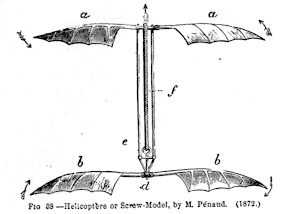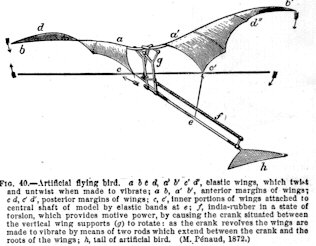Alphonse Penaud
Today, a very young man teaches us to fly, after all. The University of Houston's College of Engineering presents this series about the machines that make our civilization run, and the people whose ingenuity created them.
When I was in grade school, long ago, I loved building model airplanes powered by twisted rubber bands. Sometimes I worked from kits -- sometimes from my own imagination. Building those models taught me that I had abilities despite the devastation of undiagnosed dyslexia. They gave me hope. Now I've learned the poignant history of those models, and met the man who first built them.
He was Alphonse Penaud, born in 1850 in Paris. Penaud planned to join the Navy. Then he suffered a disabling illness. I don't know what -- only that it ended his plan. So he turned to inventing a flying machine. He was no idle dreamer. He worked methodically. He thought through questions of stability and propulsion.
Penaud was 21 when he finally perfected a rubber-band-driven model airplane. It had a wing, a tail, and a propeller in the rear. It was very close to the models kids like me were building 70 years later. He flew it in the Tuileries Gardens for all to see.
During the next ten years, Penaud thought and he experimented. Sometime before 1874, he built a rubber-band-powered helicopter that he stabilized with counter-rotating propellers -- one above and one below.
In 1875, the French Academy of Sciences awarded him a prize for his brilliant thinking. Still, Penaud meant to fly, not just to think. He went to work with a mechanic named Paul Gauchot. In 1876, they patented a full-scale airplane. For the next four years, he looked for the means to build and fly the machine.
Long before, when Penaud was only two, another French inventor, Henri Giffard, had made the first successful dirigible flight over Paris. In 1880 Penaud turned to Giffard for support in getting a heavier-than-air craft built. Giffard gave him a cold shoulder.
Penaud didn't have the emotional resources to handle that defeat. He went home and built a small wooden casket. He put all his designs into it and delivered it to Giffard's house. Then he went home and committed suicide. He was only thirty and he didn't know that Giffard was also depressive -- that, two years later, Giffard would also commit suicide.
But the fierce intelligence of Penaud's work went on to touch every would-be airplane builder from then until we got it right. Read any book on the history of flight and Penaud is there as a recurring footnote. In 1874 Bishop Milton Wright bought one of Penaud's toy helicopters. He took it home to his boys, Orville and Wilbur. And, right there, Penaud changed the course of history.
Penaud was a quiet, almost-anonymous force behind the gathering invention of flight. He was one of the more important forces, at that. His models showed inventors what was possible. But they also showed me what was possible. Long after Penaud died, his delicate models gave me hope -- just when I most needed it.
I'm John Lienhard, at the University of Houston, where we're interested in the way inventive minds work.
(Theme music)
Mackworth-Praed, B., Aviation: The Pioneer Years. Seacaucus, NJ, Chartwell Books, Inc., 1990, Chapter Two.
Angelucci, E., World Encyclopedia of Civil Aircraft. New York: Crown Publishers, Inc., 1982, Chapter 1.

Penaud's Model Airplane
(Drawing source: Encyclopaedia Britannica, 1897)

Penaud's Model Helicopter
(Drawing source: Encyclopaedia Britannica, 1897)

Penaud's Model Ornithopter
(Drawing source: Encyclopaedia Britannica, 1897)